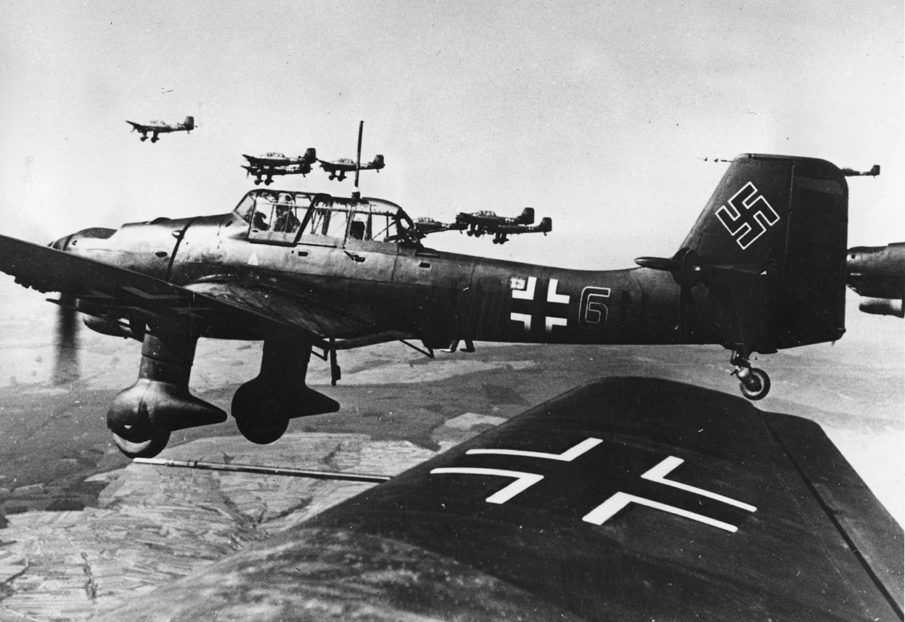On April 26, 1937 the world got its first taste of the impact of strategic air power. German aircraft belonging to the Condor Legion attacked the Basque city of Guernica. Ignoring military targets and concentrating on the civilian population, German planes killed somewhere around 1500 people and wounded thousands more. The gutted shell of the city became a symbol of the horrible power of modern arms.
Guernica was just one example of the use of the Spanish Civil War as a test bed for new aircraft and techniques by the Germans. Acting on behalf of the Spanish dictator, Francisco Franco, the Germans employed their latest aircraft, including the Heinkel He.111 and the Messerschmitt Bf.109 in support of Nationalist forces and in sweeping the skies clear of opposing Republican aircraft. The rest of the world was still hoping to appease Nazi Germany. The Germans were already rehearsing for 1939 and the Second World War.
In much the same way, the Russians are using the ongoing conflict in Ukraine to prepare for the next major war. We would do well, unlike the Allies in 1936, to sit up and take notice.
Circa 2014 Ukrainian artillery officer Yaroslavl Sherstuk developed an Android application for use by Ukrainian forces fighting against Ukrainian separatists and their Russian backers. The application allowed the Ukrainians to more rapidly process targeting data used for their Soviet era D-30 howitzers. Using the application the Ukrainians were, in fact, able to cut targeting time from minutes to seconds. The application was distributed openly on Ukrainian military forums.
From late 2014 through 2016, a Russian GRU malware implant inserted into the application developed by Sherstuk was covertly distributed on these same forums and downloaded unwittingly by large numbers of serving Ukrainian officers. According to Sherstuk, in excess of 9000 Ukrainian military personnel were at one time using the application. The malware inserted into the application by the Russians allowed them to access communications and locational data from all infected devices and to use that data to target the Ukrainian howitzer batteries.
The results were devastating. Open source reporting indicates that Ukrainian artillery forces have lost over 50% of their weapons in the 2 years of conflict and over 80% of D-30 howitzers.
This cyber attack on the Ukrainians is only one small element of the ongoing cyber operations carried out by Russian forces. In December Kiev’s power grid was hit by a major cyber attack, the latest in a long series of attacks on Ukraine’s energy and financial sectors. Large portions of the capital were left without electricity as a result of the attack. Almost exactly a year ago similar attacks resulted in blackouts across western Ukraine.
The scope of the ongoing attacks is massive. Speaking last week Ukrainian Poroshenko revealed that there have been in excess of 6500 cyber attacks on Ukraine by Russia-based actors in the last sixty days alone. The targets of those attacks include the Ukrainian finance and defense ministries as well as the State Treasury. There is no indication whatsoever that the attacks are declining in frequency or severity. To the contrary, all indications are that the attacks are increasing in sophistication and severity.
Discussing one attack on the Ukrainian electrical grid that occurred in late 2015, a Ukrainian power center employee discussed watching his computer screen being taken over literally in front of his eyes. Helpless to log in or enter commands himself, the employee simply sat and watched while his cursor moved around his screen, cutting off breakers, and text commands appeared on his screen shutting down large portions of the grid. All of this was being done remotely from somewhere inside Russia, and the Ukrainians were literally locked out of their own control systems.
While the Russians are fine-tuning their capabilities and plowing ahead, it is unclear to what extent we are keeping pace. Last year the United States delivered 72 Raven RQ-11B Analog mini-drones to the Ukrainians. There were high expectations that the drones would give the Ukrainians a much-needed capability for battlefield reconnaissance. None of the drones remain in service. They were all hacked by the Russians.
The Russians demonstrated almost immediately the capacity to jam control of the Ravens and crash them at will. Perhaps more troubling, the Russians quickly acquired the ability to remotely access all data feeds from the drones, allowing them in effect to use the drones to spy on the Ukrainian forces via their own UAVs. An advisor to the chief of the Ukrainian general staff recently stated that if it were up to him, he would return all of the Ravens to the United States.
The use of cyber capabilities by the Russians in Ukraine is not, of course, unique. Other major powers, like the United States and China, have demonstrated robust cyber capabilities of their own. No other nation, however, has shown the dedication to integrating cyber operations into an ongoing, largely conventional conflict and to constantly refining those capabilities. Russian cyber efforts on the battlefield in Ukraine are not just harassing Ukrainian citizens or making life marginally more difficult for the government of Ukraine. They are contributing directly to Russian military successes and having a demonstrable negative impact on Ukrainian capabilities.
In 1936 the Germans were hard at work refining the capabilities they would blend together only a few years later into what the world came to know as “blitzkrieg,” lightning war. What we will ultimately call what the Russians are crafting in Ukraine remains unclear. Whatever it is we had better be paying close attention and preparing to deal with it.
Image courtesy of Wikipedia










COMMENTS
You must become a subscriber or login to view or post comments on this article.